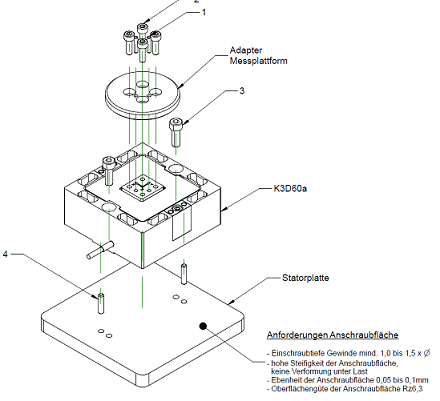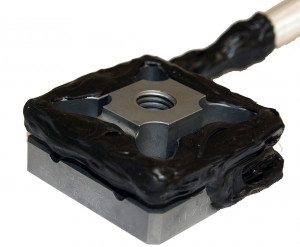3-axis force transducer 10 to 500 N - 60 x 60 x 23.5 mm - IP65
- 3-component force sensor Fx, Fy, Fz
- Measuring ranges: ± 10 N, ± 20 N, ± 50 N, ± 100 N, ± 200 N, ± 500 N in all 3 axes
- Dimension: 60 x 60 x 23.5 mm
- Accuracy: < 0.5 % PE (0.1 % optional)
- Construction: aluminium IP65
- Tension and compression measurement
- Output: 3m STC-32T-12 12 wire cable
- Weight: 110g
- Force transmission: 4 x M3x0.5 threads
- Resonance frequency: 3 kHz
Introduction
K3D60a 3-component force transducer measures simultaneously the forces Fx, Fy, Fz on three perpendicular directions. The measurement ranges on each axis are between +/-10 N and +/-500 N, the overall accuracy is 0.5% (0.1% optional), and the sensitivity to crosstalk is 1%.
The K3D60a 3-component force transducer is easily installed on machine tools, arms, or test benches. The force introduction and fixation to the stator/bench is done by 4 M3x0.5 threads, as long as the tightening torques requirements are satisfied (see here). A distance of 1 mm must be kept between the adapters and the sensor body.

The sensor is supplied with 5 VDC. The operating temperature range is -20 to 70°C. The output signal is unamplified (0.5 mV/V). The 3 output signals are decoupled by the design of the sensor, and correspond directly to the actual forces. No additional decoupling is required. The sensor is delivered with a 3m cable.
Specifications
The K3D60a sensor is available in 4 measuring ranges:
| Model | K3D60a (+/-10N) | K3D60a (+/-20N) | K3D60a (+/-50N) | K3D60a (+/-100N) | K3D60a (+/-200N) | K3D60a (+/-500N) |
|---|---|---|---|---|---|---|
| Fx, Fy, Fz | 10 | 20 | 50 | 100 | 200 | 500 |
| Maximum applicable moment | 20Nm | 20Nm | 20Nm | 20Nm | 20Nm | 20Nm |
| Electrical Connection | Câble 3 m | Câble 3 m | Câble 3 m | Câble 3 m | Câble 3 m | Câble 3 m |
| Material | Aluminium | Aluminium | Aluminium | Aluminium | Inox | Inox |
Each sensor is delivered with a factory calibration certificate. Calibration to specific measuring ranges is possible (optional), as well as ISO-17025 calibration.
Signal conditionning and acquisition
The acquisition of the raw measurement signals can be done with :
- a PC or PLC acquisition system equipped with a strain gage bridge input card
- or via a strain gage bridge conditioning module with analogue or digital output, connected to a PC or a standard acquisition system.
We recommend the following modules for signal conditioning and acquisition:
- GSV-4USB, 4 input module , USB output
- GSV-1A4, 4 input module, analog output
- GSV-8DS (High performance module, 8 analog inputs)
The visualization and acquisition software included is achieved with the provided software GSV-multi.
Applications
- Robotics
- Production
- Wind tunnel
- Quality control
- Load measurement in medicine, prosthetics, orthopedic engineering or gait analysis
- Measurement in sports medicine
- Comfort / ergonomics measurements
- Type
- beam sensor
- Number of Axis
- 3 Axis
- Precision (max error)
- 0.5 %
- Nonlinearity (% FS)
- ± 0.1 %
- Tension d'alimentation
- 10 Vcc
- Measurement direction
- Traction & Compress.
- Housing
- Aluminium
- Protection Class
- IP65
- Measuring Range (Force)
- ⩽ 1 kN, 1 - 100 kN
- Transducer Series
- K3D
- Application
- Robotics, Miniature

- Connector on cable for acquisition
- Extended temperature compensation
- Electronic conditioning and acquisition
- Connector output on request
- TEDS module
- Conditioning electronics
- Display
- Specific wiring
Produits associés

K3D120 - 3 axes - IP66 - 50 N à 5 kN

K6D68

TR3D-B - 3 axes - miniature - 1,1 à 72 kN


